Followers of Hinduism need no introduction to the significance of the Jyotirlingas. They are well aware of their importance and hold them in the highest esteem. These 12 shrines (i.e., the twelve Jyotirlingas) are scattered across India, embodying the radiant presence of Lord Shiva in every corner of the country. However, are you aware that the Great State of Maharashtra alone is home to 5 out of 12 Jyotirlingas in the country?
The five Jyotirlingas in the state are collectively known as the Panch Jyotirlingas, and they occupy a unique position within Hinduism. Every year, millions of devotees embark on pilgrimages to these holy sites, take part in paying their respect in reverence to Lord Shiva. If you are a devotee, you can’t afford not to make this pilgrimage. However, before you start packing for your journey, you must get a bit more familiar with the holy sites that you will be visiting. Here, we have delved into these sites, one by one. We have explored their rich history, captivating legends behind them as well as practical details to guide you on your own transformative journey to the Panch Jyotirlingas.
These are the five holy sites that are collectively known as the Panch Jyotirlingas in Maharashtra –
1- Bhimashankar Temple
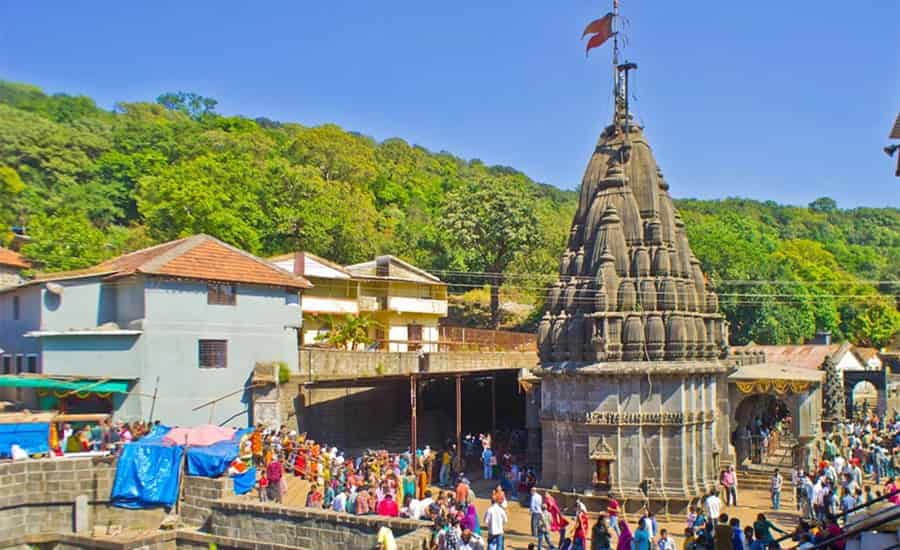
The very first Jyotirlingas we will be looking at is the Bhimashankar Temple, located near Pune in Maharashtra. This magnificent temple is tucked away within the breathtaking Sahyadri hills, standing as a testament to the unwavering faith of the devotees and architectural artistry. A closer look at the temple reveals the influence of Nagara-style architecture, which is characterized by its gracefully curving tower reaching the heavens. The influence of the Rajasthani and Gujarati architectural styles can also be seen here. On the outer walls of the temple, you can easily find many exquisite carvings displaying scenes and stories covering many epics. You can also easily find depictions from Mahabharata, Ramayana, and more beautifully carved on these walls.
The Bhimashankar Temple, one of the sacred twelve Jyotirlingas and located around 123 km away from the city of Pune, holds a special significance for devotees of Lord Shiva. It is believed that this is the place where Lord Shiva, the Supreme Hindu God of Creation & Destruction, manifested in all his radiant power.
The temple is believed to have been constructed in the 13th century. However, the present structure was constructed (or, you can say, strengthened) in the 18th century. During this reconstruction, the Sabha mandap, or the open assembly hall, and the temple’s Shikhara were built.
Another thing to know about this holy site is the presence of the holy Kund near it. The Kushavarta Kund, as it is commonly known, is filled with water from the river Godavari. Legends speak about how this is the exact place where the holy Godavari River emerges from the ground. Make sure that you visit this holy site during the Mahashivratri festival, as the atmosphere during this time is simply breathtaking.
Legends Surrounding This Temple
The Bhimashankar Temple is a holy site surrounded by many mysteries and legends, starting with its origins. The legends speak about how Bhima, the son of Kumbhakarna, terrorized people. He was blessed by Lord Brahma, making him all-powerful and immune from pretty much everything. In their despair, sages and gods beseeched Lord Shiva to do something. Lord Shiva himself descended to confront Bhima, ending him once and for all. The Bhimashankar Temple is an eternal monument to this victory.
Another legend speaks about the time when Lord Shiva defeated a fearsome demon named Tripurasura who plagued these lands. Heeding the calls for help, Lord Shiva took the form of Ardhanariswara, vanquishing the demon and restoring peace to this land. Following his victory, the gods implored Shiva to establish a permanent presence in the region to safeguard it from future threats. Accepting their request, Shiva chose this very spot, where the Bhima River is said to have sprung forth from his sweat during the battle.
- Address: Bhorgiri, Khed Taluka, Maharashtra; the temple is located around 123 km away from the city of Pune
- Darshan Timing: 5 AM to 9.30 PM
2- Trimbakeshwar Temple
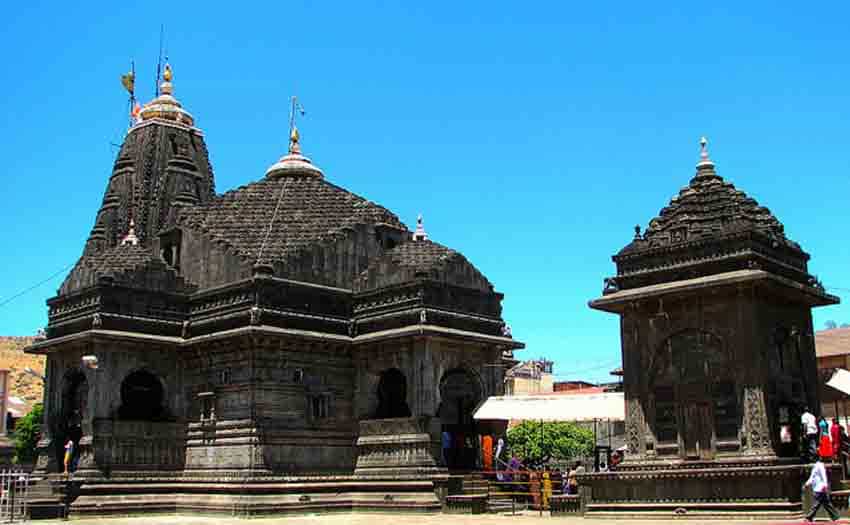
The next holy site on our list is the iconic Trimbakeshwar Temple, located at a distance of about 28 km from the beautiful city of Nashik. The short distance from a major population center makes this temple one of the most visited holy sites in the state. This revered temple sits at the foothills of the Brahmagiri mountain range, providing tourists with an amazing view of the surroundings. You will find the mesmerizing river Godavari flowing alongside the temple, adding to the serene ambiance of this holy site.
The Trimbakeshwar Temple architecture is also noteworthy, drawing eyeballs of architects and historians alike. While the origin of the original structure is shrouded in mystery, the present structure was built under the patronage of Balaji Baji Rao in the 17th century. The temple is crafted entirely from black stone, making it one of a kind of structure. Now, if we are talking about the uniqueness of this temple, then we can’t not talk about the distinct Jyotirlinga that has manifested itself here. Here, unlike the other Jyotirlingas, the Linga is present with three faces. These represent the three Supreme Gods of Hinduism: Brahma, Vishnu & Mahesh.
Additionally, just a short distance from the temple, you will find the sacred Kushavarta Kund. Constructed in the year 1750, this is another site that is popular amongst the devotees of Lord Shiva.
Legends Surrounding This Temple
Like many other ancient temples, you will find that the origins of Trimbakeshwar are lost to time. However, there are many legends about this temple that have survived for hundreds of years. There is one captivating story that has stood the test and speaks about Gautam Rishi. He was a renowned sage who accidentally caused the death of a cow. Killing this holy animal is one of the gravest sins in all of Hinduism.
Plagued by this guilt, the sage pleaded with Lord Shiva to bring the Ganga river to him so he could absolve himself of his sin. Moved by his sincerity & devotion, Lord Shiva released a small portion of the mighty Ganga. It is this part that becomes what we know today as the Godavari River.
Another legend speaks about a celestial treasure, a magnificent lingam adorned with diamonds gifted by the Sun God. However, this sparked jealousy within other Gods, and in their attempt to steal it, this divine object fell to the earth. From the spot where it landed, the Jyotirlinga of Trimbakeshwar temple emerged.
- Address: Shrimant Peshwe Path, Trimbak, Maharashtra
- Darshan Timing: 5.30 AM to 9 PM
3- Grishneshwar Temple
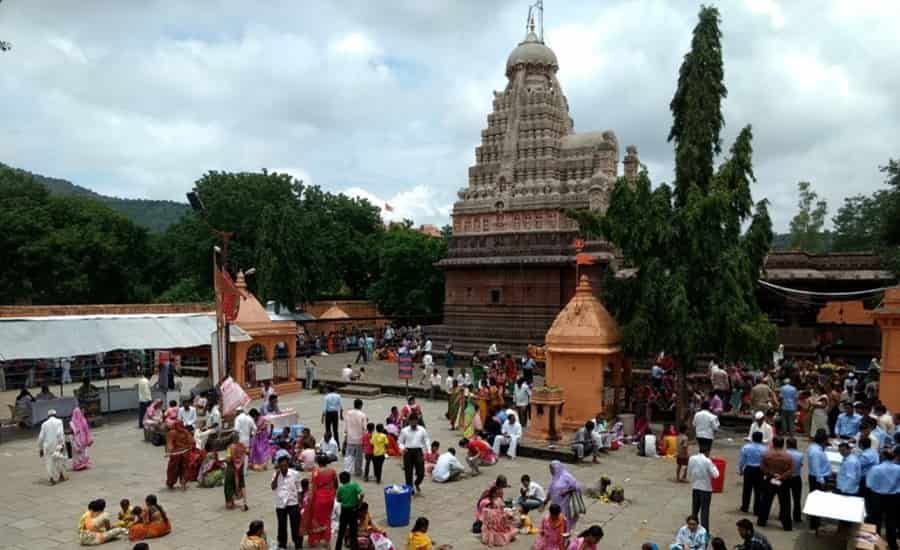
Our journey through the Panch Jyotirlingas in Maharashtra next lands us at Grineshwar Temple. The temple is located near the city of Aurangabad, and while it might be considered the smallest of all the Jyotirlingas, it does not diminish its value among its devotees. In fact, its vibrant five-story, crafted from a mix of red and black stone and offering a unique contrast, makes it a popular attraction for both devotees and tourists alike.
Another noteworthy fact about this temple is how it departs from the typical architectural style of the region. Unlike the more Rajasthani and Gujarati architectural styles that are commonplace in other constructs in the area, Grishneshwar temple boasts a distinct South Indian influence. This, along with its proximity to the UNESCO World Heritage Site of Ellora Caves, adds a fascinating layer to its history.
Now, the origin of this temple is not quite clear, though the record does suggest an even more ancient origin (preceding the 13th century). However, the current structure do dates back to the 18th century, when it was rebuilt after the tragic destruction of an earlier temple. It was reconstructed thanks to the patronage of the Queen of Indore, Ahilyabai Holkar.
Legends Surrounding This Temple
Now on the legends of this temple – and there are several of them. The very name of this holy site, ‘Grishneswar’ comes from the pious woman named Grishna, who was a devotee to Lord Shiva. In her devotion to Lord Shiva and her longing for a child, she used to create and worship 101 lingas every day.
Her prayers were finally answered, and she gave birth to a son. But her joy was shattered when her sister, in jealousy, cast the child into the lake. Broken-hearted, Grishna still continued her prayer to Lord Shiva, who, moved by her unshakable devotion, restored her son to life. Humbled by her selflessness, Shiva manifested here as a Jyotirlinga, a radiant symbol of his compassion and the enduring power of faith.
- Address: Ghrishneshwar Temple Rd, Verul, Aurangabad, Maharashtra
- Darshan Timings: 5.30 AM to 9.30 PM
4- Aundha Nagnath Temple
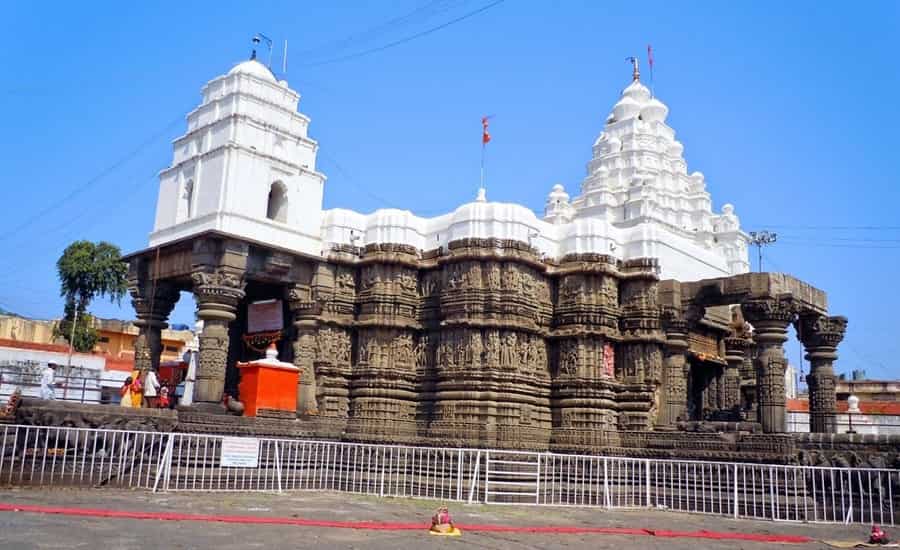
Our Panch Jyotirlinga pilgrimage next takes us to the revered Aundha Nagnath Temple. The holy site is located in the Hingoli district and around 70 km away from Nanded. Counted as the 8th of the 12 Jyotirlingas, this temple holds immense significance for devotees of Lord Shiva. However, what makes this temple unique among this list is who constructed this temple. It is believed that the original structure of the Aundha Nagnath Temple was built by Yudhishthira – the eldest of the five Pandava brothers.
However, the current structure was constructed during the 13th century under the patronage of the Yadava dynasty. Naturally, it has seen massive repairs over the years, partially because of centuries of conflict in and around the region and even the relentless march of time — both of which had damaged the temple over the years. The structure that we admire today is believed to have been partially rebuilt during the later Peshwa era, specifically the upper portion of the temple, which was ruined due to vandalism by enemy invaders.
Despite the changes to its structure, the Aundha Nagnath temple still resonates with a profound sense of spirituality — its significance in the eyes of devotees has not ebbed even a tiny bit. Every year, millions of devotees visit the Aundha Nagnath Temple and seek blessings from Lord Shiva. The temple complex also houses carvings of divine figures and scenes from Hindu mythology – it certainly adds to the spiritual experience of the devotees. However, the most unique feature of the Aundha Nagnath is the location of the Jyotirlinga itself. Unlike other temples where the Jyotirlinga is more visible, here, the pilgrims have to descend into the temple’s depths.
Legends Surrounding This Temple
The origins of Aundha Nagnath Temple are also shrouded in mystery. Yes, it is something that we have said for almost every other temple on this list, but it does not make it any less true! The very nature of these ancient sacred sites often means that their beginnings are often woven with captivating legends, their stories passed down through generations. And the same is true for Aundha Nagnath Temple as well.
One legend of this temple speaks about how it was built by the Pandava brothers during their years of exile from Hastinapur. It tells us the story of how the Pandava brothers noticed that upon drinking water from a nearby river, the cows of this region offer milk in return. They sensed the presence of a higher power, so they dug the river, and there they found a Shiva Lingam in the place. That is where they constructed this temple.
- Address: Nanded – Aundha Road, Aundha Nagnath, Hingoli, Maharashtra
- Darshan Timings: 4 AM to 9 PM
5- Parli Vaijnath Temple
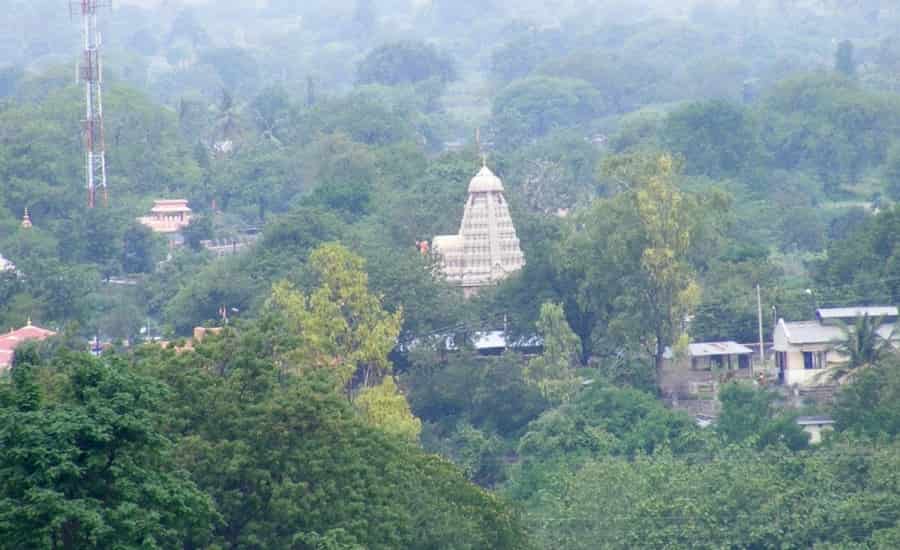
Our Panch Jyotirlinga pilgrimage concludes with a visit to the Parli Vaijnath Temple. This temple, located in the Beed district of Maharashtra, is revered as one of the twelve Jyotirlingas and holds profound significance for devotees. A closer look at the Beed Temple and you will immediately notice the influence of the Hemadpanthi style in the design. Another unique aspect of this temple is the make of the Jyotirlinga — it is one built of the Shaligram stone and is also steeped in legend.
While we are not 100% sure about the origins of the temple, historical records suggest its construction dates back to the 18th century and to the time of Queen Ahilyabai Holkar of Indore. She oversaw the renovation of this temple, and while the temple might not be as elaborate as some of the other temples we have explored, but its significance is undeniable.
Now, let’s talk a bit about the temple itself. The temple rises over 75 feet above the surface, and the main hall and the sanctum santorum are on the same level. This allows for the unobstructed view of the Jyotirlinga. The temple complex also boasts a majestic courtyard, a brass-plated main gate, and sacred ponds. This only adds to the serenity and grandeur of this place.
If you truly wish to enjoy the beauty of this temple, you should plan your visit during festivals like Mahashivratri, Ekadashi, or even Vijayadashami. This would allow you to enjoy the vibrant celebrations during these special occasions.
Legends Surrounding This Temple
Several legends are associated with this temple, something that should be known to anyone by now. One legend speaks about the compelling tale that recounts the epic story of Samudra Manthan. During this, fourteen precious treasures were released, including Dhanvantari and Amrit. During the struggle with the demons, Lord Vishnu concealed these treasures within a Shiva Linga. Angered, the demons attacked the Linga; however, they were evaporated by its power. This is the story behind why this place is also known as Vaijnath, meaning the “place of victory.”
Another captivating legend involves Ravana, the demon king of Lanka. Ravana was a proud devotee of Lord Shiva, and after his years of rigorous penance, he received a blessing from Lord Shiva. In his blessing, he asked Lord Shiva to come with him to his kingdom of Lanka. Shiva granted him a Shiva linga to carry back, but with a strict warning: he must not set the linga down anywhere along the journey. However, during his travels, Ravana, needing to rest, entrusted the Shiva linga to a shepherd, who in turn placed it on the ground. From that moment, the linga became immovable. And the place where the Shiva Linga was placed is exactly where the Parli Vaijnath Temple stands today.
- Address: Parli Vaijnath, Beed, Maharashtra
- Darshan Timings: 5 AM to 9 PM
Final Words
There you have it folks – the Panch Jyotirlingas in Maharashtra. Here, we have tried to explain all of these magnificent sites located in this great state. Each temple has a unique story of its own to tell. Whether you are a devotee of Lord Shiva or an explorer drawn by the legends of these holy sites, these sacred sites offer you a profound experience. So what are you waiting for — book your travels now!

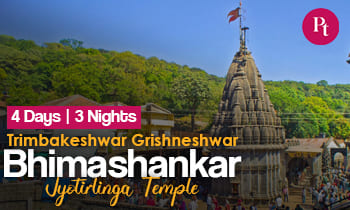
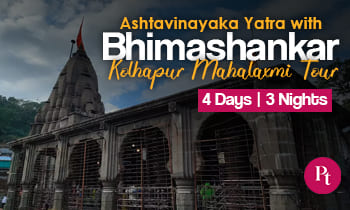
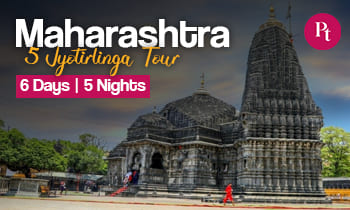
 Call
Call WhatsApp
WhatsApp Enquiry
Enquiry